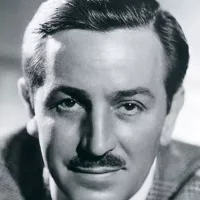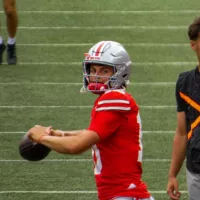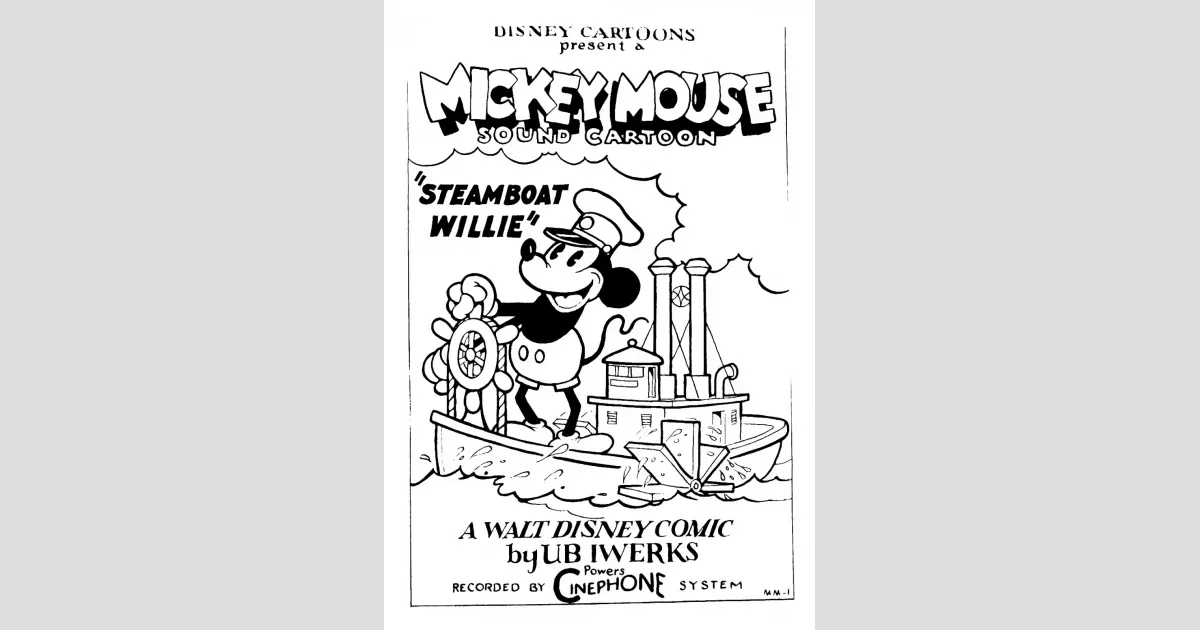Steamboat Willie, a 1928 animated short film directed by Walt Disney and Ub Iwerks, marked the public debut of Mickey and Minnie Mouse. While not their first appearance, it was the first Mickey Mouse cartoon to be distributed due to Disney's commitment to synchronized sound, inspired by The Jazz Singer. Produced in black and white by Walt Disney Animation Studios and released by Pat Powers, it holds a significant place in animation history as one of the earliest cartoons with fully synchronized sound.
1909: Copyright Act of 1909
In the 1990s, Gregory S. Brown determined that under the rules of the Copyright Act of 1909, Steamboat Willie was likely already in the public domain.
May 1924: Inkwell Studios' Song Car-Tunes Begin
In May 1924, Dave and Max Fleischer's Inkwell Studios began producing sound cartoons as part of the Song Car-Tunes series.
1924: Song Car-Tunes Series
In 1924, Inkwell Studios started producing sound cartoons as part of the "Song Car-Tunes" series.
1925: Appearance of Pete in Alice Solves the Puzzle
In 1925, Pete appeared as the villain in Alice Solves the Puzzle.
September 1926: Inkwell Studios' Song Car-Tunes End
In September 1926, Dave and Max Fleischer's Inkwell Studios ended the Song Car-Tunes series.
1926: Song Car-Tunes Series End
In September 1926, the "Song Car-Tunes" series from Dave and Max Fleischer's Inkwell Studios ended.
June 1927: Pat Powers Bids for Phonofilm Corporation
In June 1927, producer Pat Powers made an unsuccessful takeover bid for Lee de Forest's Phonofilm Corporation.
1927: Walt Disney Inspired by The Jazz Singer
In 1927, Walt Disney was inspired by The Jazz Singer to create a sound cartoon, believing it would increase appeal.
1928: Steamboat Willie becomes popular
In 1928, Steamboat Willie distinguished itself from earlier sound cartoons and became the most popular cartoon of its day, solidifying Disney's belief in synchronized sound as the future of film.
1928: Release of Steamboat Willie
In 1928, Steamboat Willie was released and gained wide critical acclaim for introducing Mickey Mouse and for its technical innovation.
1928: Steamboat Willie Released
In 1928, Steamboat Willie, directed by Walt Disney and Ub Iwerks, was released as an animated short film. Produced in black and white by Walt Disney Animation Studios and released by Pat Powers, it marked the public debut of Mickey and Minnie Mouse and was notable for being one of the first fully synchronized sound cartoons.
1928: Promotional Poster Created
In 1928, a promotional poster featuring Mickey Mouse in red shorts and yellow gloves was created, raising questions about whether those attributes are also now in the public domain.
1928: Copyright Filed for Steamboat Willie
In 1928, copyright was filed for Steamboat Willie.
1930: Powers and Disney Falling-Out
In 1930, Powers and Disney had a falling-out over money, and Powers hired away Disney's lead animator, Ub Iwerks.
1955: Steamboat Willie Copyright Extended
In 1955, the copyright for Steamboat Willie was renewed to 1986.
1971: Death of Ub Iwerks
In 1971, Ub Iwerks, the last surviving director of Steamboat Willie, died.
1976: Copyright Act of 1976
In 1976, the Copyright Act extended the copyright of Steamboat Willie to 2003.
1986: Steamboat Willie Copyright Extended Again
In 1986, the copyright for Steamboat Willie was extended to 2003 by the Copyright Act of 1976.
May 1989: Possible Copyright Expiration in Japan
Many believed that the copyright of Steamboat Willie expired in May 1989 in Japan.
1992: Steamboat Willie Parody on The Simpsons
In 1992, The Simpsons episode "Itchy & Scratchy: The Movie" featured a parody of Steamboat Willie entitled Steamboat Itchy.
1993: Steamboat Willie music in Disneyland
In 1993, a shortened cover of Steamboat Willie's music was arranged to be featured in the background ambiance of Mickey's Toontown in Disneyland.
1994: Steamboat Willie-Themed Level in Mickey Mania
In 1994, a Steamboat Willie-themed level was featured in the video game Mickey Mania.
1994: Steamboat Willie Voted 13th-Greatest Cartoon
In 1994, animators voted Steamboat Willie as the 13th-greatest cartoon of all time in the book "The 50 Greatest Cartoons".
1998: Steamboat Willie Selected for Preservation
In 1998, Steamboat Willie was selected by the United States Library of Congress for preservation in the National Film Registry.
1998: Censored version on "The Spirit of Mickey"
In 1998, a variant of the censored version of Steamboat Willie was featured on the VHS/Laserdisc compilation special "The Spirit of Mickey", reinstating part of a previously removed scene.
1998: Copyright Term Extension Act
In 1998, the Copyright Term Extension Act, also known as the "Mickey Mouse Protection Act", extended the copyright of Steamboat Willie to 2023.
1998: "Steamboat Willie" Reference in Saving Private Ryan
In the 1998 film Saving Private Ryan, set in 1944, a German prisoner of war, nicknamed "Steamboat Willie", tries to win the sympathy of his American captors by talking about Mickey Mouse.
1999: Copyright Claim Project Posted Online
In 1999, Lauren Vanpelt posted her project online agreeing with Brown's claim that Steamboat Willie was already in the public domain.
2003: Copyright Length Extended in Japan
In 2003, Japan extended the copyright length for films to 70 years, but it did not revive already expired copyrights.
2003: Steamboat Willie Copyright Extended Further
In 2003, the copyright for Steamboat Willie was extended to 2023 by the Copyright Term Extension Act of 1998.
2007: Walt Disney Animation Studios' production logo
In 2007, a Steamboat Willie clip of Mickey whistling started being used for Walt Disney Animation Studios' production logo.
2007: Disney's Use of Steamboat Willie as Logo
Since 2007, Disney's use of the Steamboat Willie version as a logo in its films may allow them to claim protection for the 1928 version under trademark law.
2008: Steamboat Willie Parody in Futurama Movie
In the 2008 film of the TV series Futurama titled The Beast with a Billion Backs, the opening is a parody of Steamboat Willie.
2019: Lego Steamboat Willie set release
In 2019, Lego released an official Steamboat Willie set to commemorate the 90th anniversary of Mickey Mouse.
May 2020: Film Enters Public Domain in Japan
According to the Copyright Act of Japan, in May 2020, the copyright for Steamboat Willie expired and the film entered the public domain in Japan.
2022: Republican Lawmakers Vow to Oppose Copyright Extension
Beginning in 2022, several Republican lawmakers vowed to oppose any future attempt to extend the copyright term due to Disney's opposition of the Florida Parental Rights in Education Act.
January 2023: Mickey & Minnie's Runaway Railway attraction
In January 2023, the whistle sound from the film was incorporated into the Mickey & Minnie's Runaway Railway attraction, which opened at Disneyland.
April 2023: John Oliver Announces Use of Steamboat Willie Mickey
In April 2023, John Oliver announced his intention to use the Steamboat Willie version of Mickey Mouse as the new mascot for Last Week Tonight with John Oliver as soon as the cartoon entered the public domain in 2024.
July 2023: Disney Releases Steamboat Silly
In July 2023, as part of their 100-year anniversary, Disney released a The Wonderful World of Mickey Mouse special and series finale entitled Steamboat Silly featuring multiple copies of Mickey as he appears in Steamboat Willie.
2023: Steamboat Willie Versions in Disney Speedstorm
In 2023, the Steamboat Willie versions of Mickey Mouse and Pete are featured as playable racers in Disney Speedstorm.
2023: Steamboat Willie Copyright Set to Expire
In 2023, the copyright of Steamboat Willie was set to expire before finally entering the public domain on January 1, 2024.
January 1, 2024: Steamboat Willie Enters Public Domain
On January 1, 2024, Steamboat Willie entered the public domain in the United States.
2024: Steamboat Willie Enters Public Domain
In 2024, Steamboat Willie entered the public domain, resulting in numerous re-uploads of the film.
2052: Alleged Copyright Protection Until 2052
Some people alleged that Mickey Mouse would remain protected until 2052 in Japan.
Mentioned in this timeline
Lego is a line of plastic construction toys created by...

Walter Elias Disney was a highly influential American animator film...

Disneyland located in Anaheim California is the first theme park...
Japan is an East Asian island country situated in the...
Florida a state in the Southeastern United States is largely...

A car also known as an automobile is a wheeled...
Trending

1 month ago Patrick Dempsey stars in 'Memory of a Killer' thriller, premiering on Fox this January.
Army Sustainment University ASU is the U S Army's sustainment training center for military and civilian personnel offering Professional Military...

2 hours ago Johnny Depp Describes His Life with Vanessa Paradis as 'Blissful' in Recent Statement.
2 hours ago Will Howard and Jack Sawyer: From College Rivals to Steelers Teammates Amid Brawl.
2 hours ago Brian Hartline Rumors, Potential Replacements, and Chip Kelly's Impact Analyzed.

3 hours ago Julian Sayin: Ohio State's Key to Michigan Victory; Quarterback's Debut Anticipated
Popular
Aftyn Alyssa Behn is an American politician currently serving as...

William Franklin Graham III commonly known as Franklin Graham is...

Candace Owens is an American conservative political commentator and author...

XXXTentacion born Jahseh Dwayne Ricardo Onfroy was a controversial yet...

Marjorie Taylor Greene known as MTG is a U S...

Richard Branson is a prominent English business magnate best known...
